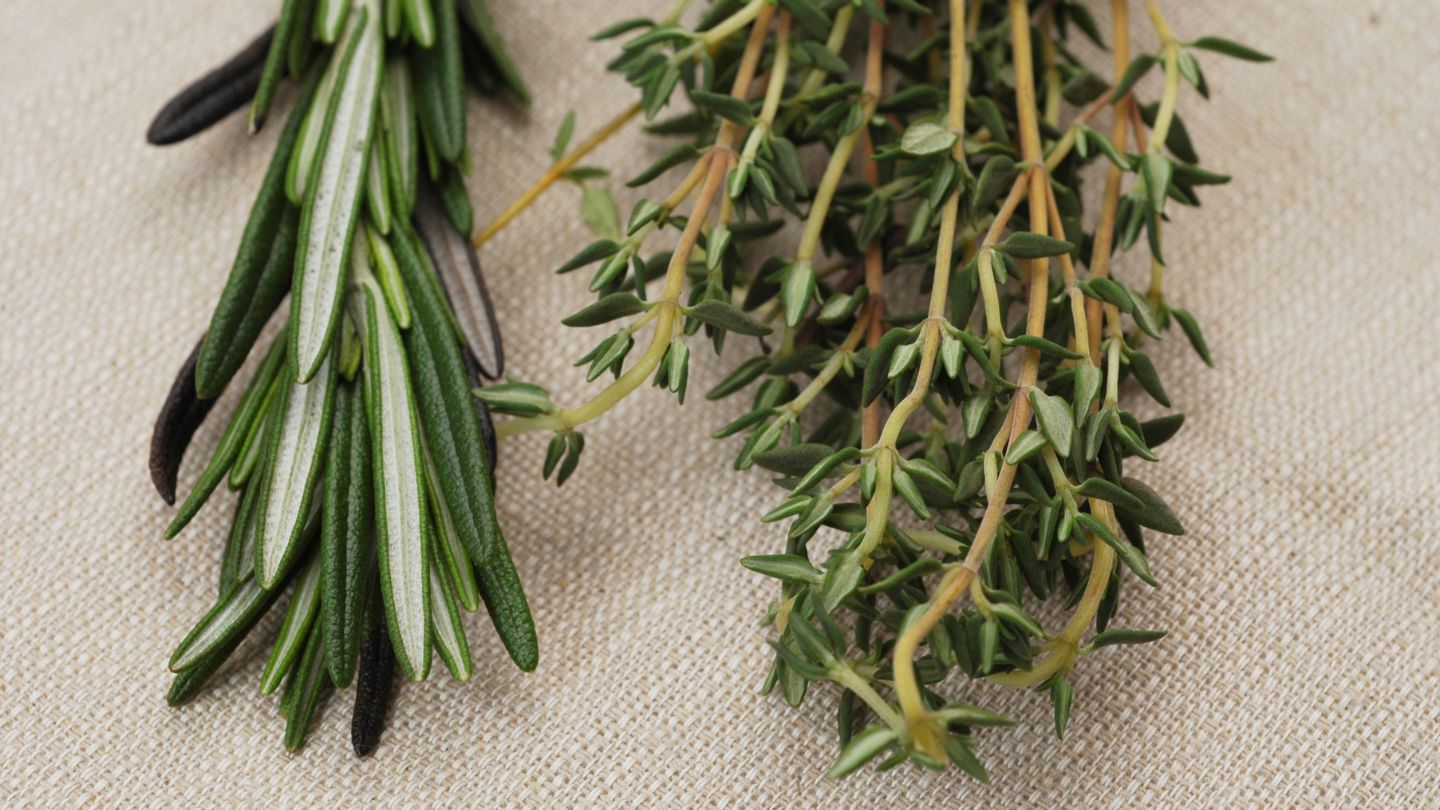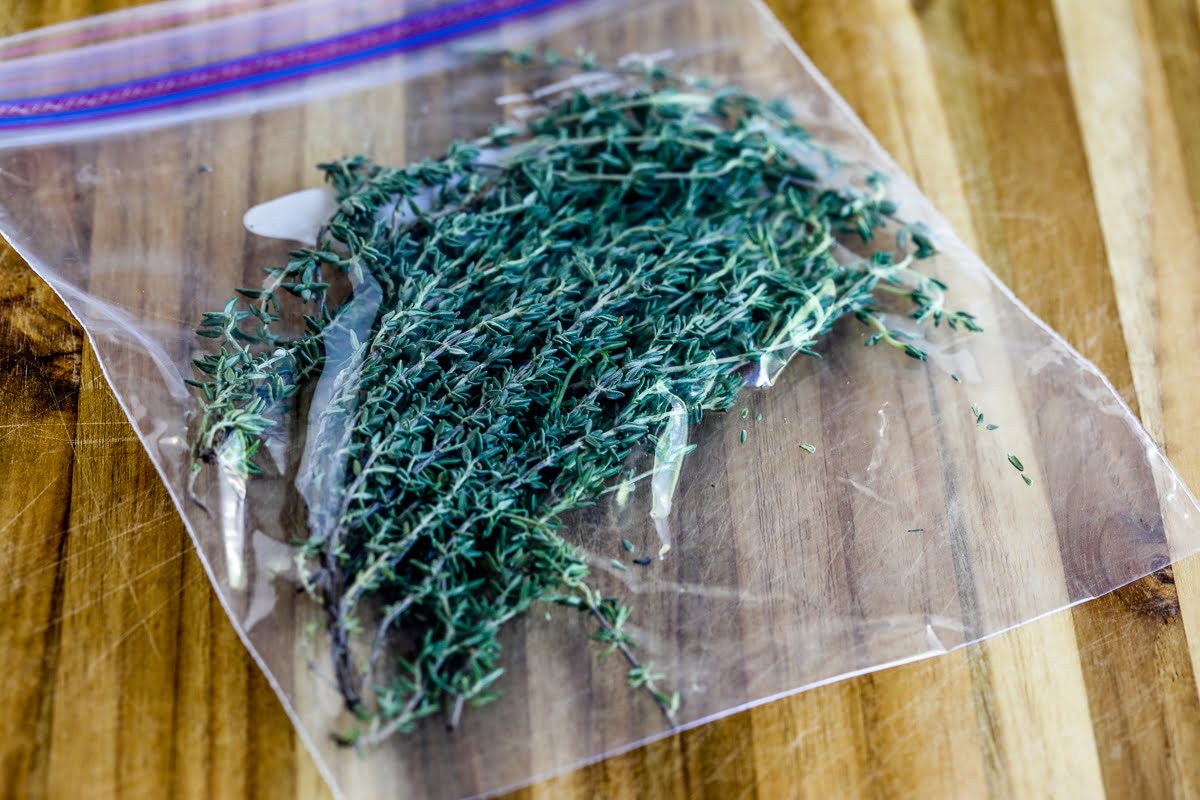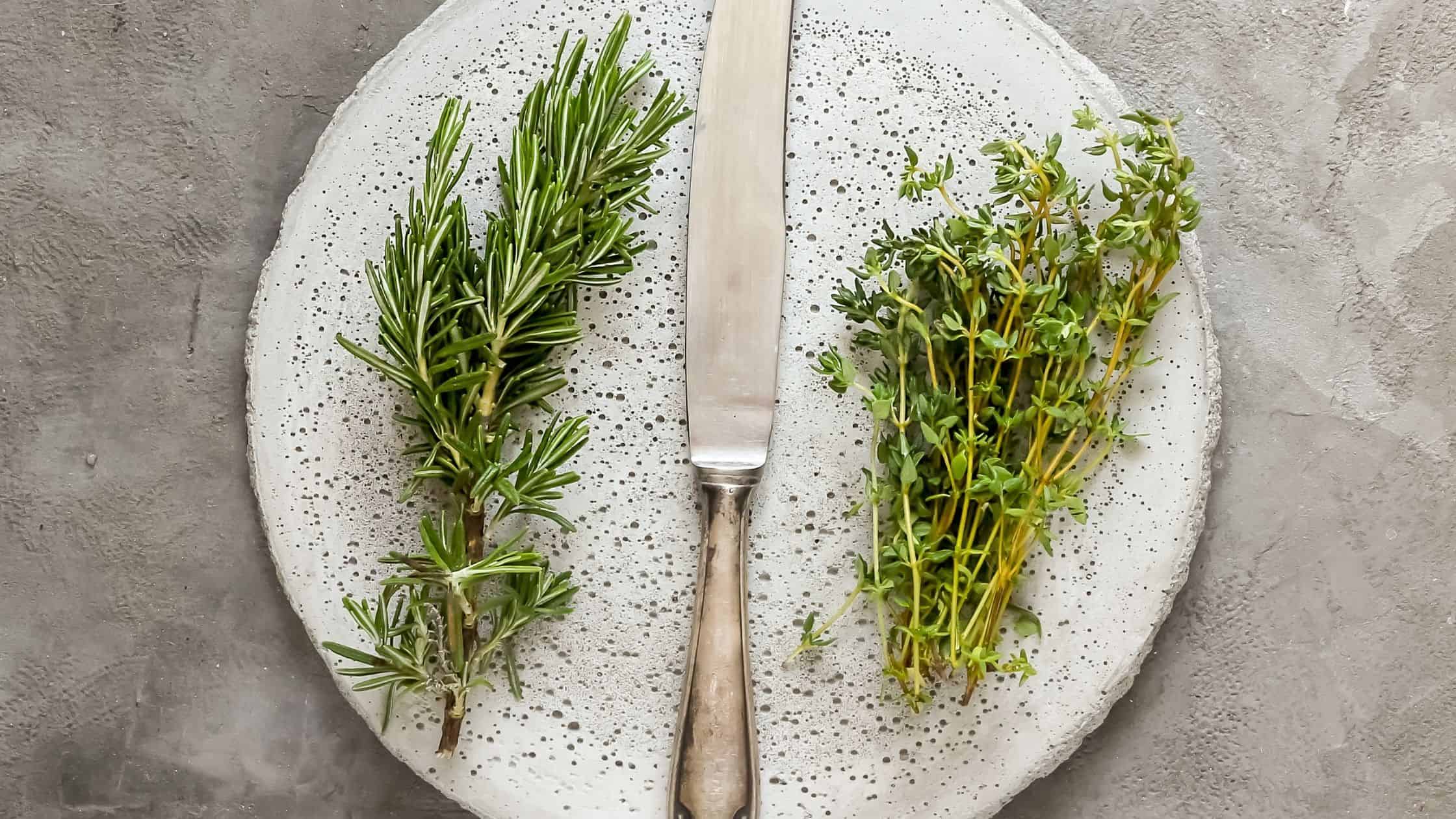Home>Garden Essentials>Garden Plants>What Is The Difference Between Thyme And Rosemary


Garden Plants
What Is The Difference Between Thyme And Rosemary
Modified: January 5, 2024
Discover the key distinctions between thyme and rosemary, both popular plants in culinary and medicinal applications. Uncover their unique flavors, aromas, and uses.
(Many of the links in this article redirect to a specific reviewed product. Your purchase of these products through affiliate links helps to generate commission for Storables.com, at no extra cost. Learn more)
Introduction
When it comes to herbs that add robust flavors and delightful aromas to our culinary creations, thyme and rosemary stand out as popular choices. These two herbs, although similar in some ways, have distinct characteristics that set them apart. Understanding their differences not only helps us elevate our dishes but also enhances our gardening and medicinal knowledge.
Originating from different regions and belonging to different plant families, thyme and rosemary offer unique flavors, aromas, and health benefits. Whether you’re an avid cook, a gardening enthusiast, or someone who appreciates natural remedies, exploring the distinct qualities of these herbs will surely pique your interest.
In this article, we will delve into the origins, flavor profiles, culinary uses, medicinal properties, growing tips, and storage techniques of thyme and rosemary. By the end of this journey, you’ll have a comprehensive understanding of these remarkable herbs and be inspired to incorporate them into your everyday life.
Key Takeaways:
- Thyme and rosemary offer distinct flavors, aromas, and health benefits, making them essential additions to culinary creations, gardening endeavors, and natural remedies.
- Understanding the origins, characteristics, and culinary uses of thyme and rosemary enhances appreciation for these versatile herbs and inspires creative and flavorful dishes.
Origins and Plant Characteristics
Thyme and rosemary both have fascinating origins and possess unique plant characteristics that distinguish them from one another.
Thyme, scientifically known as Thymus vulgaris, is native to the Mediterranean region and has been used for centuries in cooking and herbal medicine. This perennial herb belongs to the Lamiaceae family and is characterized by its small, aromatic leaves and woody stems. Thyme plants typically grow to a height of 6 to 12 inches and feature tiny flowers in shades of white, pink, or purple. The leaves of thyme are narrow, elliptical in shape, and contain tiny glands that release the herb’s distinct aroma when crushed.
Rosemary, on the other hand, is native to the Mediterranean and is scientifically known as Rosmarinus officinalis. Belonging to the Lamiaceae family, this perennial herb is known for its needle-like, evergreen leaves and woody stems. Rosemary plants can reach a height of 2 to 6 feet and produce small, blue flowers. The leaves are narrow, about 1 to 2 inches long, and have a slightly curved shape. What sets rosemary apart is its strong fragrance, reminiscent of pine and lemon.
Both thyme and rosemary are hardy plants that can tolerate various soil conditions and thrive in full sun. They require well-draining soil and moderate watering, but they can withstand drought once established. These herbs are also suitable for container gardening, making them excellent choices for those with limited space.
While thyme and rosemary share some similarities in terms of their plant characteristics, such as their woody stems and aromatic leaves, their distinct features give them unique identities in the realm of herbs.
Flavor and Aroma Profile
Thyme and rosemary differ significantly when it comes to their flavor profiles and aromas, making them distinct herbs that add depth and complexity to culinary creations.
Thyme has a strong, earthy flavor with hints of mint and lemon. Its taste is often described as herbaceous and slightly sweet. Thyme leaves can be used both fresh and dried, and they offer a bold punch of flavor to dishes. The aroma of thyme is herbaceous and inviting, with a subtle hint of floral notes. It adds a delightful fragrance to soups, stews, roasted meats, and vegetables.
Rosemary, on the other hand, has a robust, pine-like flavor with citrus undertones. Its taste is intense, slightly bitter, and has a characteristic resinous quality. Both fresh and dried rosemary leaves pack a flavor punch, making it a popular choice for flavoring meats, especially lamb and poultry. The aroma of rosemary is distinctively aromatic, with a strong pine-like scent that is both invigorating and comforting. It fills the air with its pleasant fragrance, making it a favorite herb for infusing oils and vinegar.
When using thyme and rosemary in cooking, it is essential to consider their differing flavor profiles. Thyme pairs exceptionally well with dishes that include tomatoes, mushrooms, potatoes, and grilled meats. Its versatility allows it to shine in various cuisines, from Mediterranean to French and beyond. On the other hand, rosemary’s strong flavor makes it an ideal complement to hearty, savory dishes such as roasted vegetables, poultry, and game meats. It adds a distinctive and aromatic touch to dishes, elevating them to new heights.
Whether you choose to use thyme or rosemary in your culinary adventures, their unique flavors and aromas will undoubtedly enhance your dishes and impress your taste buds.
Culinary Uses
Thyme and rosemary have been cherished for centuries for their culinary versatility. These herbs not only add flavor and aroma to dishes but also offer unique characteristics that enhance the overall dining experience.
Thyme is a staple herb in many cuisines around the world. Its earthy and slightly sweet flavor lends itself well to a wide range of dishes. Fresh or dried thyme leaves are commonly used in soups, stews, and marinades, adding depth and complexity to the flavors. Thyme also pairs beautifully with roasted vegetables, grilled meats, and poultry, imparting a delightful aroma and taste. Additionally, it is a key ingredient in the classic French herb blend known as “herbes de Provence,” which combines thyme with other herbs such as rosemary, oregano, and marjoram.
Rosemary, with its strong and fragrant flavor, is often used to add a punch to savory dishes. It is particularly popular in Mediterranean and Italian cuisines. Fresh rosemary sprigs are commonly used as a seasoning for roasted meats, such as lamb, beef, and chicken. The hearty flavor of rosemary pairs perfectly with rich, oily fish like salmon as well. It also adds a fragrant touch to roasted potatoes, bread, and even sweets like cookies and cakes. The aromatic oils in rosemary infuse dishes, elevating them to new heights of deliciousness.
Both thyme and rosemary can be used in various forms, including fresh, dried, and as infused oils or vinegars. This allows for greater flexibility when incorporating them into your favorite dishes. Whether you’re simmering a hearty stew, creating a flavorful marinade, or simply garnishing a dish, these herbs provide an abundance of culinary options to explore.
Experimenting with thyme and rosemary in your kitchen will open doors to a world of flavors and endless possibilities. Let your taste buds guide you as you discover the perfect combination of these herbs to take your dishes from ordinary to extraordinary.
Medicinal Properties
Beyond their culinary uses, both thyme and rosemary offer a range of medicinal properties that have been valued for centuries. These herbs contain compounds that have been studied for their potential health benefits.
Thyme has long been recognized for its antibacterial and antifungal properties. It contains thymol, a compound known for its antimicrobial effects. Thyme has been traditionally used to treat respiratory ailments, including coughs, bronchitis, and sore throats. It can be brewed into a soothing tea or used as an ingredient in homemade cough syrups. Thyme also contains antioxidants that may help support overall immune health. Additionally, thyme oil has been used topically for its antiseptic properties and to aid in wound healing.
Rosemary is known for its antioxidant and anti-inflammatory properties. It contains rosmarinic acid, a compound that has been studied for its potential to protect against inflammation and oxidative stress. Rosemary has been used traditionally to improve digestion, alleviate muscle pain, and enhance memory and concentration. It is also believed to have a calming effect on the nervous system. Rosemary essential oil is commonly used in aromatherapy to promote relaxation and reduce stress.
As with any herbal remedy, it is important to consult with a healthcare professional before using thyme or rosemary for medicinal purposes. While these herbs have a long history of use and are generally regarded as safe, individual reactions and potential drug interactions should be taken into consideration.
Thyme and rosemary offer not only enticing flavors and aromas in the kitchen but also potential health benefits. Exploring their medicinal properties can add another dimension to your appreciation of these remarkable herbs.
Thyme has a subtle, earthy flavor, while rosemary has a stronger, pine-like flavor. Use thyme for delicate dishes and rosemary for robust flavors like roasted meats.
Read more: What To Do With Fresh Thyme And Rosemary
Growing and Harvesting
Whether you’re an experienced gardener or just starting out, growing thyme and rosemary can be a rewarding endeavor. These herbs are relatively easy to cultivate and can be grown in both outdoor gardens and indoor containers.
Thyme can be grown from seeds, cuttings, or transplants. It thrives in well-draining soil with a pH range of 6 to 8. Choose a sunny location for your thyme plants, as they require at least 6 hours of direct sunlight per day. If you’re growing thyme indoors, place the container near a south-facing window or provide supplemental fluorescent lighting. Water thyme plants regularly, allowing the soil to dry out slightly between waterings. Overwatering can lead to root rot, so be sure to strike a balance. As the plant grows, you can trim the tips of the stems to encourage bushier growth. Thyme is ready to harvest when the stems are at least 4 inches long. Simply cut the stems just above the point where new growth begins.
Rosemary can also be grown from seeds, cuttings, or transplants. Like thyme, rosemary prefers well-draining soil with a pH of 6 to 8. It’s a sun-loving herb that requires at least 6 hours of direct sunlight daily. Rosemary is more sensitive to cold temperatures and may need protection during frosty periods. Water your rosemary plants sparingly, allowing the top inch of soil to dry out between waterings. Prune rosemary regularly to maintain its shape and promote bushiness. Harvest by cutting off the top few inches of the stems, being mindful not to take too much at once, as it may slow down the plant’s growth.
Both thyme and rosemary can be dried for long-term storage. To dry the herbs, tie them in small bundles and hang them upside down in a well-ventilated area away from direct sunlight. Once the leaves are dry and brittle, remove them from the stems and store them in airtight containers in a cool, dark place.
By following these simple guidelines, you can enjoy a bountiful harvest of fresh thyme and rosemary, right from your home garden or kitchen windowsill.
Pairing with Other Ingredients
Thyme and rosemary are versatile herbs that pair well with a variety of ingredients, enhancing the flavors and adding depth to dishes. Here are some fantastic combinations to explore in your culinary adventures:
- Meats: Both thyme and rosemary work wonders with various meats. Thyme complements chicken, beef, lamb, and pork beautifully. It adds a savory note to meat dishes and balances out their flavors. Rosemary is particularly fantastic with lamb, infusing it with its robust and aromatic qualities. It also pairs well with grilled or roasted chicken, beef, and game meats.
- Seafood: While thyme is not typically associated with seafood dishes, it can add a subtle and refreshing touch. Sprinkle some thyme leaves over grilled or baked fish, shrimp, or scallops for a burst of flavor. On the other hand, rosemary pairs well with oily fish like salmon, adding a unique earthy note that complements the rich flavors of the fish.
- Vegetables: Both thyme and rosemary can enhance the flavors of a wide variety of vegetables. Thyme goes well with root vegetables like potatoes, carrots, and parsnips, adding a pleasant earthiness. It also pairs beautifully with mushrooms, enhancing their umami flavors. Rosemary adds a distinct aroma to roasted or grilled vegetables, such as zucchini, eggplant, and bell peppers. It can transform simple roasted potatoes into a flavorful side dish.
- Herb Combinations: Thyme and rosemary can be used together to create delightful herb blends. Try combining them with other herbs like oregano, parsley, sage, and marjoram to create your own unique flavor profiles. These herb combinations can be used to season meat, poultry, vegetables, and even homemade bread.
- Sauces and Marinades: Thyme and rosemary add depth and complexity to sauces, gravies, and marinades. They work particularly well in tomato-based sauces, enhancing the flavors and adding a savory element. Fresh or dried thyme and rosemary can be added to marinades for meats, infusing them with their distinctive flavors.
These are just a few examples of the many possibilities when it comes to pairing thyme and rosemary with other ingredients. Feel free to experiment and let your taste buds guide you in creating delicious and well-balanced dishes.
Storage and Preservation
Proper storage and preservation techniques are essential to ensure the longevity and quality of thyme and rosemary. Whether you have an abundance of fresh herbs from your garden or want to make the most out of store-bought herbs, here are some tips to keep them fresh:
1. Refrigeration: For fresh thyme and rosemary, wrap the herbs in a slightly damp paper towel and place them in a plastic bag or airtight container. Store them in the refrigerator’s crisper drawer or in the warmest part of the fridge, typically around 40°F (4°C) to 50°F (10°C). Properly sealed, fresh thyme can last up to two weeks, while rosemary can last up to three weeks.
2. Freezing: Freezing is an excellent method to preserve the flavor and aroma of thyme and rosemary. Simply remove the leaves from the stems, chop them if desired, and place them in an airtight container or freezer bag. Alternatively, you can freeze whole sprigs. Thyme and rosemary can be frozen for up to six months. Frozen herbs are best used in cooked dishes rather than as a garnish.
3. Drying: Drying is a traditional method of preserving herbs. Gather fresh thyme or rosemary sprigs and tie them together into small bundles. Hang them upside down in a dark, well-ventilated area until the leaves become dry and crumbly. Remove the dried leaves from the stems and store them in airtight containers in a cool, dark place. Dried thyme and rosemary can retain their flavor for up to a year.
4. Infused Oils and Vinegars: Thyme and rosemary can be used to infuse oils and vinegars, providing a convenient way to add flavor to your dishes. Place fresh or dried thyme or rosemary in a clean, airtight jar and cover it with your choice of oil or vinegar. Allow the mixture to steep for at least a week, shaking the jar occasionally. Strain out the herbs and transfer the infused oil or vinegar to a clean container. Store it in a cool, dark place to preserve the flavors.
By following these storage and preservation methods, you can enjoy the flavors and aromas of thyme and rosemary all year round. Whether they’re fresh, frozen, dried, or infused, these herbs will continue to add their unique essence to your culinary creations.
Conclusion
Thyme and rosemary, two remarkable herbs with distinct characteristics, have captured our palates and imaginations for centuries. From their origins in the Mediterranean region to their culinary and medicinal uses, these herbs offer a wealth of flavors, aromas, and benefits that continue to inspire cooks, gardeners, and health enthusiasts around the world.
Thyme, with its earthy and slightly sweet taste, adds depth to a variety of dishes, from soups and stews to grilled meats and roasted vegetables. Its antibacterial and antifungal properties make it a valuable herb in both culinary and medicinal applications. Rosemary, on the other hand, boasts a robust and pine-like flavor that complements hearty meats and adds an aromatic touch to roasted vegetables. Its antioxidant and anti-inflammatory benefits have been cherished for centuries.
Growing thyme and rosemary is a rewarding experience, whether you have a spacious garden or a small indoor space. These herbs can thrive in diverse environments, enhancing your green thumb skills and providing you with a steady supply of flavorful leaves.
When it comes to pairing thyme and rosemary with other ingredients, the possibilities are endless. They effortlessly elevate the flavors of meats, seafood, vegetables, sauces, and marinades, making them indispensable in the kitchen. Their compatibility with various herbs also opens up a world of creativity for adventurous cooks.
To ensure the longevity of thyme and rosemary, proper storage and preservation techniques are vital. From refrigeration and freezing to drying and infusing, these methods help you savor the freshness and essence of these herbs year-round.
In conclusion, thyme and rosemary are more than just herbs; they are sources of culinary inspiration, gardening joy, and potential health benefits. Whether you’re a passionate cook, an aspiring gardener, or someone seeking natural remedies, embracing the unique qualities of thyme and rosemary will greatly enrich your culinary experiences and beyond.
Frequently Asked Questions about What Is The Difference Between Thyme And Rosemary
Was this page helpful?
At Storables.com, we guarantee accurate and reliable information. Our content, validated by Expert Board Contributors, is crafted following stringent Editorial Policies. We're committed to providing you with well-researched, expert-backed insights for all your informational needs.















0 thoughts on “What Is The Difference Between Thyme And Rosemary”